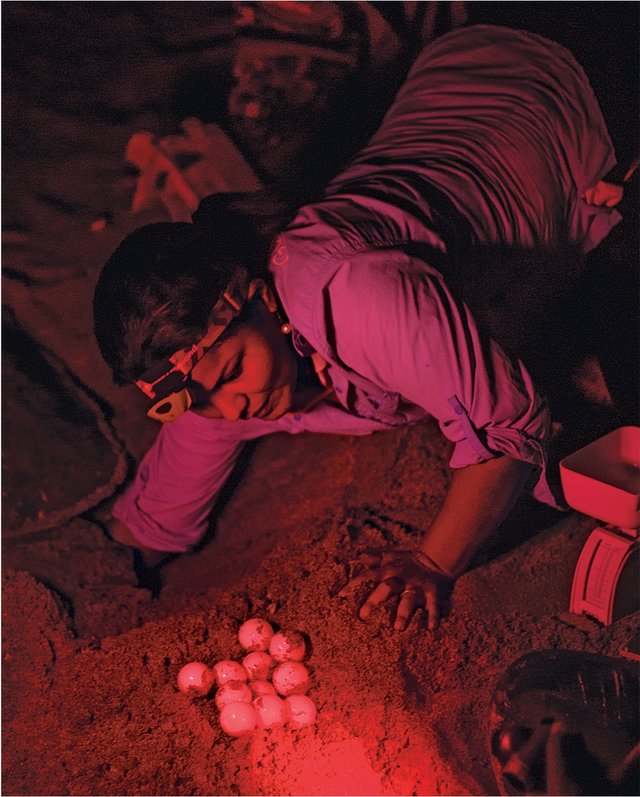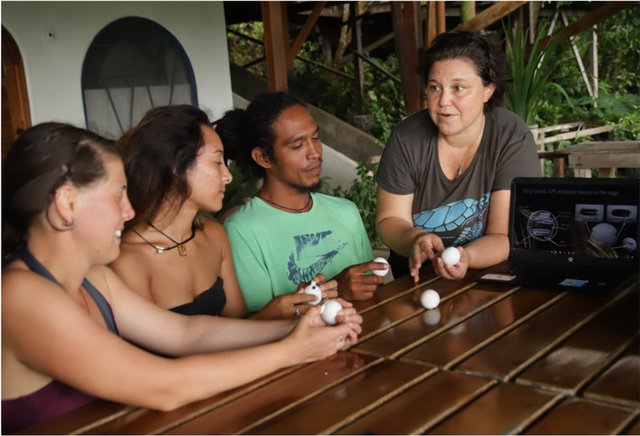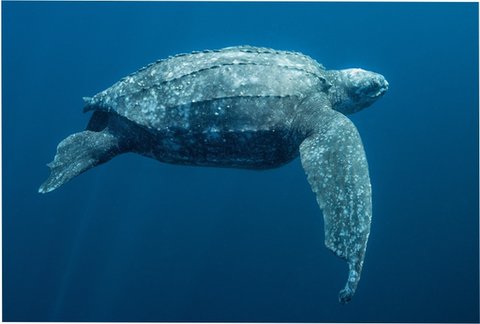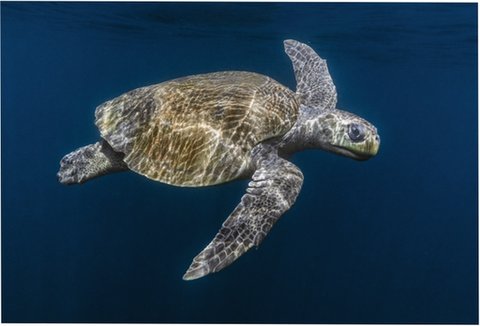FindingaPartner
PasoPacíficoneededapartner.ItteamedupwithwildlifebiologistHelenPheasey.PheaseywasdoingfieldworkinCostaRicaandwaswillingtoplantsomedecoy eggs.
Hermissionwasthreefold.First,sheneededtoseeifthetechnologyintheeggswouldworkinthefield.Second,sheneededtoseeifthedesignofthefakeeggscouldtrickpoachers.Andthird,sheneededtomakecertainthatthepresenceofthefakeeggsdidnotdisturbthehealthofthereal eggs.
Sofar,thenewshasbeengood.Thehealthyeggsarenotbotheredbythefakeeggs.Thepoachershavebeenfooled.Andthetrackingworks.Pheaseywasabletotracksomeofthedecoystolocaldestinationsandanothertothemiddleofariver,some60kilometers(37miles)awayfromthenest.Shethinksapoachermayhavediscoveredthetrackerandabandoneditinthe river.
Thesystemisn’tperfect.Limitedcellularnetworkscouldlimittheirabilitytotracktheeggsinsomeplaces.Poacherswilleventuallyfindthetrackers.But,itisagood start.

APasoPacificoturtlerangercollectsturtleeggsforsafekeeping nearby.

KimWilliams-Guillenexplainstovolunteershowthefakeseaturtleeggs work.
WhatComesNext
Deployingmorefakeeggsisthenextstep.Themoredatatheyhave,theeasieritwillbetogenerateamaptoshowhow—andwhere—theeggsaretraded.Thefakeeggsareawaytoshiftthefocusawayfromthepoachersthemselvestowherethepoachersaregoing.Thatwillhelptheteambetterunderstandthedemandforturtle eggs.
ExpertsbelievemostofthestoleneggseventuallymaketheirwayoutofNicaragua,possiblytoElSalvadororGuatemala.However,thereisalsoaconcernthatseaturtleeggsarebeingshippedoverseas.Ifthisistrue,itcouldmeannewmarketsforpoachedeggs –makingthetradethatmuchmoredifficultto combat.
Theinformationgatheredbytheteamcouldhelppolicecapturepoachers.Inplaceswheregovernmentsdon’tprioritizeprotectingtheeggs,thedatacouldbeusedinother ways.
Forexample,thedatacouldfueleducationalcampaignsabouttheturtles.Itcouldalsobeusedforconservationprojects,suchasbeachpatrolstomonitorthe nests.
Williams-Guilléndoesn’tthinkherfakeeggswillsolvetheproblemofturtleeggpoaching.Butshedoesthinkitcouldbeapowerfultool.Combinedwithotherconservationefforts,itcouldhelpensurethatseaturtlesaresafeforthe future.

Protectingseaturtlesalsoprotectstheenvironment.Healthyoceansneedsea turtles.
Seaturtlesareanimportantpartofahealthymarineecosystem.YetNicaragua,whosebeacheshavelongbeencrucialnestinggrounds,hasseenasharpdeclineinsea turtles.

green seaturtle
Length:100centimeters (3.2 feet)
Weight:180kilograms (397 pounds)
Presence:CaribbeanCoast,Pacific Coast
Status: Endangered
ManygreenturtlesarecaughtinNicaraguafor food.
Seaturtlesareanimportantpartofahealthymarineecosystem.YetNicaragua,whosebeacheshavelongbeencrucialnestinggrounds,hasseenasharpdeclineinsea turtles.

hawksbillseaturtle
Length: upto94centimeters (3 feet)
Weight: 80kilograms (176 pounds)
Presence: CaribbeanCoast,Pacific Coast
Status: Critically Endangered
Theshellofthehawksbillturtleisoftenusedtomake souvenirs.
Seaturtlesareanimportantpartofahealthymarineecosystem.YetNicaragua,whosebeacheshavelongbeencrucialnestinggrounds,hasseenasharpdeclineinsea turtles.

leatherbackseaturtle
Length:150centimeters (5 feet)
Weight:upto700kilograms (1,543 pounds)
Presence:CaribbeanCoast,Pacific Coast
Status:Critically Endangered
Theleatherbackturtleisthelargestseaturtlelivingon Earth.
Seaturtlesareanimportantpartofahealthymarineecosystem.YetNicaragua,whosebeacheshavelongbeencrucialnestinggrounds,hasseenasharpdeclineinsea turtles.

oliveridleyseaturtle
Length:upto74centimeters(2.4 feet)
Weight:45kilograms (100 pounds)
Presence:Pacific Coast
Status:Vulnerable
Oliveridleyturtlesarethemostabundantseaturtle,yettheyarestill endangered.